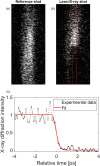Repetitive non-thermal melting as a timing monitor for femtosecond pump/probe X-ray experiments
- PMID: 32984435
- PMCID: PMC7511237
- DOI: 10.1063/4.0000020
Repetitive non-thermal melting as a timing monitor for femtosecond pump/probe X-ray experiments
Abstract
Time-resolved optical pump/X-ray probe experiments are often used to study structural dynamics. To ensure high temporal resolution, it is necessary to monitor the timing between the X-ray pulses and the laser pulses. The transition from a crystalline solid material to a disordered state in a non-thermal melting process can be used as a reliable timing monitor. We have performed a study of the non-thermal melting of InSb in single-shot mode, where we varied the sample temperature in order to determine the conditions required for repetitive melting. We show how experimental conditions affect the feasibility of such a timing tool.
© 2020 Author(s).
Figures








References
-
- Lindenberg A. M., Johnson S. L., and Reis D. A., “ Visualization of atomic-scale motions in materials via femtosecond x-ray scattering techniques,” Annu. Rev. Mater. Res. 47, 425–449 (2017).10.1146/annurev-matsci-070616-124152 - DOI
-
- Buzzi M. et al., “ Probing dynamics in quantum materials with femtosecond x-rays,” Nat. Rev. Mater. 3(9), 299–311 (2018).10.1038/s41578-018-0024-9 - DOI
-
- Moeller S. et al., “ Photon beamlines and diagnostics at LCLS,” Nucl. Instrum. Methods Phys. Res. Sect. A 635, S6–S11 (2011).10.1016/j.nima.2010.10.125 - DOI
-
- Milne C. J. et al., “ SwissFEL: The Swiss x-ray free electron laser,” Appl. Sci. 7(7), 720 (2017).10.3390/app7070720 - DOI
LinkOut - more resources
Full Text Sources

